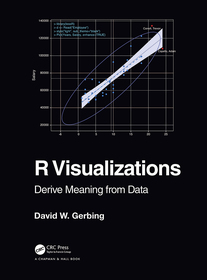
R Visualizations
Derive Meaning from Data
- Publisher's listprice GBP 42.99
-
20 538 Ft (19 560 Ft + 5% VAT)
The price is estimated because at the time of ordering we do not know what conversion rates will apply to HUF / product currency when the book arrives. In case HUF is weaker, the price increases slightly, in case HUF is stronger, the price goes lower slightly.
- Discount 10% (cc. 2 054 Ft off)
- Discounted price 18 484 Ft (17 604 Ft + 5% VAT)
Subcribe now and take benefit of a favourable price.
Subscribe
20 538 Ft

Availability
Estimated delivery time: In stock at the publisher, but not at Prospero's office. Delivery time approx. 3-5 weeks.
Not in stock at Prospero.
Why don't you give exact delivery time?
Delivery time is estimated on our previous experiences. We give estimations only, because we order from outside Hungary, and the delivery time mainly depends on how quickly the publisher supplies the book. Faster or slower deliveries both happen, but we do our best to supply as quickly as possible.
Product details:
- Edition number 1
- Publisher Chapman and Hall
- Date of Publication 13 December 2021
- ISBN 9781032243276
- Binding Paperback
- No. of pages280 pages
- Size 280x210 mm
- Weight 598 g
- Language English
- Illustrations 100 Illustrations, black & white 220
Categories
Short description:
This book is focused on one of the two major topics of doing data analysis: data visualization, aka, computer graphics. In one place the major R systems for visualization are discussed, organized by topic and not by system. Anyone doing data analysis will be shown how to use R to generate basic visualizations with any of R visualization systems.
MoreLong description:
R Visualizations: Derive Meaning from Data focuses on one of the two major topics of data analytics: data visualization, a.k.a., computer graphics. In the book, major R systems for visualization are discussed, organized by topic and not by system. Anyone doing data analysis will be shown how to use R to generate any of the basic visualizations with the R visualization systems. Further, this book introduces the author’s lessR system, which always can accomplish a visualization with less coding than the use of other systems, sometimes dramatically so, and also provides accompanying statistical analyses.
Key Features
- Presents thorough coverage of the leading R visualization system, ggplot2.
- Gives specific guidance on using base R graphics to attain visualizations of the same quality as those provided by ggplot2.
Shows how to create a wide range of data visualizations: distributions of categorical and continuous variables, many types of scatterplots including with a third variable, time series, and maps.
- Inclusion of the various approaches to R graphics organized by topic instead of by system.
- Presents the recent work on interactive visualization in R.
David W. Gerbing received his PhD from Michigan State University in 1979 in quantitative analysis, and currently is a professor of quantitative analysis in the School of Business at Portland State University. He has published extensively in the social and behavioral sciences with a focus on quantitative methods. His lessR package has been in development since 2009.
'Finally, this is an easy- to-read book to begin the data visualization by using R for those who want to start or to develop their background in R for data visualization. It is a good companion to facilitate the use of R for data visualization with less coding than the better known ggplot2 package.'
- Sébastien Bailly, International Society for Clinical Biostatistics, 71, 2021
MoreTable of Contents:
1. R, Data and Visualizations. 2. R Visualization Quick Start. 3. Customization. 4. Visualize the Distribution of a Categorical Variable. 5. Visualize the Distribution of a Continuous Variable. 6. Visualize the Distributions of Values over Time. 7. Visualize Spatial Data with Maps. 8. Visualize Three Dimensions. 9 Visualize Dimensionality Reduction. 10. Interactive Visualizations.
More



